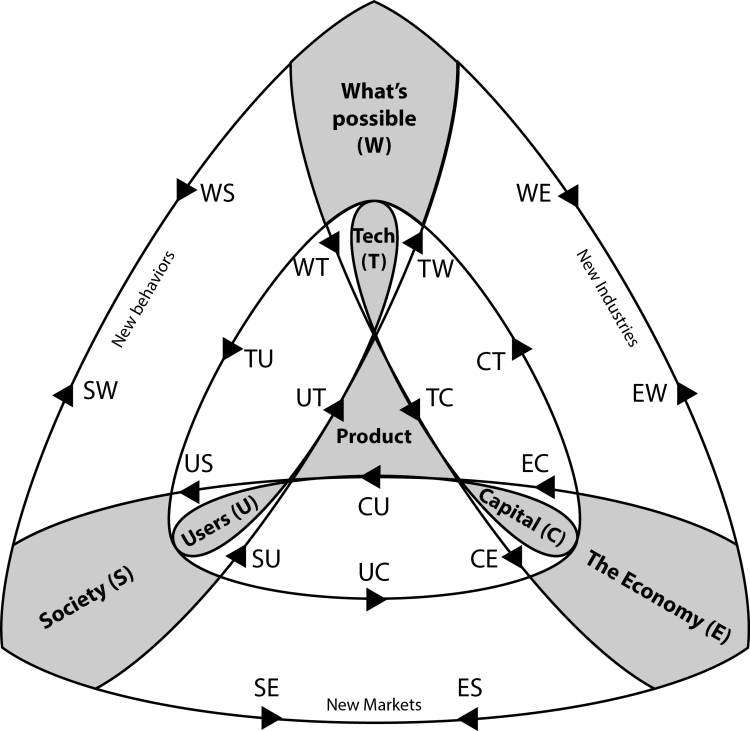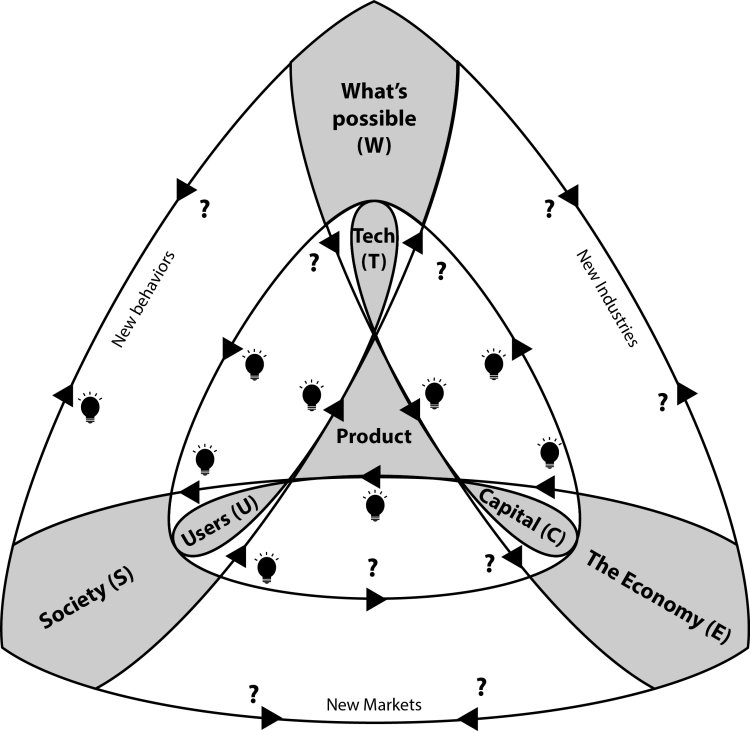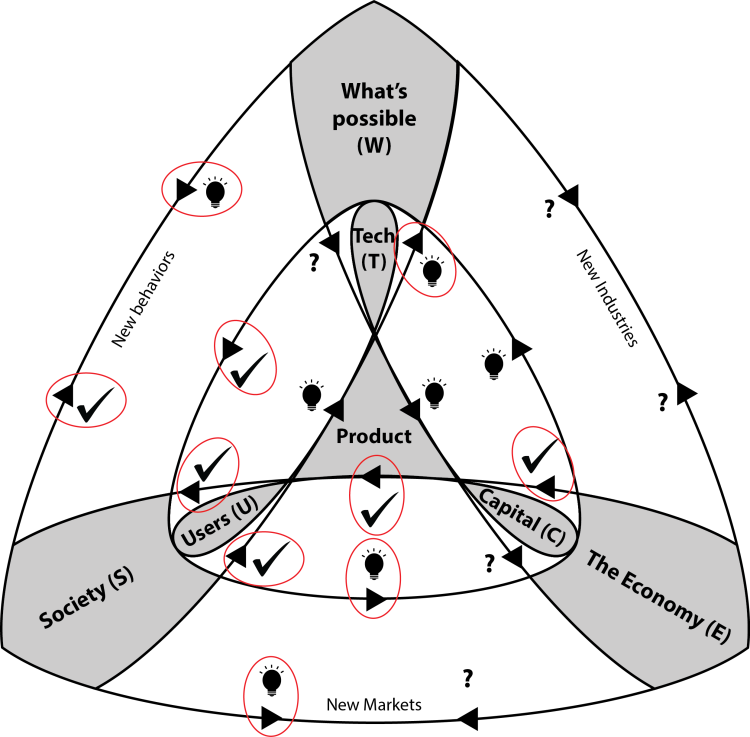In product development, situational awareness requires a continuous sense of (1) a product vision and (2) the current state of your product in relation to that vision. Without such understanding, contributors are fundamentally disoriented, either directionless or oblivious to the facts.
Maintaining situational awareness is non-trivial due to the fluid interplay between product vision and state. When the product vision shifts, contributors must reinterpret the purpose of their active work. Inversely, discoveries on the front lines can inspire or force vision reform. When a group of people is involved, the potential for stale situational awareness is high.
So how do we manage the interplay between product vision and state? Given its foundational nature, I would expect there to be a framework to structure our thinking in this regard. But as far as I can tell, no system like this exists. While it is commonplace for companies to articulate their vision and evaluate their situation, the popular patterns are insufficient.
When one thinks of “product vision,” Facebook’s mission “to give people the power to share and make the world more open and connected” might come to mind. While inspiring, it doesn’t shed light on the concrete work necessary to win markets. Great companies connect the layers from the abstract to the tangible.
Business plan formats, like lean canvas, provide actionable product direction, but only within the narrow confines of established markets and user problems. Visionary companies aspire to do more — “changing the world” entails creating new markets and behaviors.
Agile and lean startup methodologies, based on short iterations and feedback loops, are optimized for situational awareness. Yet, while they keep you tuned into the state of your product, they don’t offer structure for how to expess a product vision. Vision is left as the magical antecedent of the development process.
A framework for situational awareness in product development must meet the following criteria.
- It can express a company’s “world-changing” vision.
- It can represent a company’s strategy for winning markets, and how that connects to their larger vision.
- It can capture the status of a company’s situation, relative to the components of #1 and #2.
In my last piece, The Fundamental Tension in Product, I introduced a model for how great companies paradoxically “change the world” while operating within the world as it is now. By way of a diagram (re-posted below), I explained how companies use orientation loops to win markets and use markets as stepping stones for realizing their grander visions. In the first iteration, my goal was only to describe the phenomena of the most impactful products.

Now, I’m going to extend the framework to represent “product vision” and “product state” in a manner that meets the criteria defined above. My hope is to provide a practical format to help ambitious product teams grasp where they are, where they’re going, and how they’re going to get there.
Let’s look at this version of the diagram where all 18 directional links have been labeled.

Each arrow is labeled according to the nodes in the product system the link connects. For example, “CT” labels the link going from Capital (C) to Tech (T). Conversely, “TC” labels the link going the other way, from Tech to Capital.
It’s all about the links. Your product vision is how you see the links forming. Your product state is the current status of each link.
Let’s dig into product vision. You can express your vision by answering a subset of questions, each corresponding to a particular link in the system.
1. How will you win your market?
- CT. What will you build?
- TU. What’s your value proposition?
- UC. How will you monetize?
2. What’s your approach?
- TC. How will you build?
- UT. How will you understand users?
- CU. How will you acquire users?
3. How will you change your environment?
- US. How will your users change society?
- CE. How will your business model change the economy?
- TW. How will your technology open new doors for other builders?
4. How will changes in your environment benefit you?
- SU. How will social trends create new users?
- EC. How will economic changes improve your financial situation?
- WT. How will technology advancements open development pathways?
5. How will you “change the world”?
- SW. How will social changes, sparked by your product, facilitate new technology advancements?
- WS. How will technology advancements, sparked by your product, change society?
- WE. How will technology advancements, sparked by your product, change the economy?
- EW. How will changes to the economy, sparked by your product, facilitate new technology advancements?
- ES. How will changes to the economy, sparked by your product, change society?
- SE. How will changes to society, sparked by your, change the economy?
As I mentioned above, your product vision need not address all these questions. A less ambitious company may only strive to win their market and not spark broader change; e.g., if you’re selling cupcakes. They would only have answers in sections 1 and 2. Ambitious companies, as well, limit the scope of their visions. It’s a common pattern for VC funded startups to postpone plans around monetization while they focus, first, on user growth and social impact. They don’t address link UC, “How will you monetize?”, out the gate. Furthermore, companies should be cognizant of their inability to predict the full consequence of their product. While the economic impacts of a product like Uber can, in some ways, be anticipated, the social impact is more tenuous to forecast.
The key is that companies should make explicit what’s included and not included in their visions. Everyone in a company should know which links they are attempting to create, and which ones will be ignored, temporarily or permanently. To represent the scope of a product vision, I’ve created a visual vocabulary where you can attach one of the following icons to each arrow in the diagram.
- Lightbulb. You have a vision for how the link will be formed.
- Question mark. You don’t know how or if the link will be formed.
To illustrate, I speculate Facebook’s original vision looked roughly like this.

Here’s my guess for how they approached each link in the product system.
1. How will you win your market?
- CT. What will you build? A social network.
- TU. What’s your value proposition? Connect with your peers.
- UC. How will you monetize? Unknown.
2. What’s your approach?
- TC. How will you build? We’ll build it ourselves.
- UT. How will you understand users? They are fellow college students.
- CU. How will you acquire users? One college at a time.
3. How will you change your environment?
- US. How will your users change society? They will spread social networking.
- CE. How will your business model change the economy? Unknown.
- TW. How will your technology open new doors for other builders? Unknown.
4. How will changes in your environment benefit you?
- SU. How will social trends create new users? The spread of social networking will grow demand.
- EC. How will economic changes improve your financial situation? The VC industry will fuel our growth before we monetize.
- WT. How will technology advancements open development pathways? Unknown.
5. How will you “change the world”?
- SW. How will social changes, sparked by your product, facilitate new technology advancements? Social networking behaviors will change how people use the Web.
- WS. How will technology advancements, sparked by your product, change society? Unknown.
- WE. How will technology advancements, sparked by your product, change the economy? Unknown.
- EW. How will changes to the economy, sparked by your product, facilitate new technology advancements? Unknown.
- ES. How will changes to the economy, sparked by your product, change society? Unknown.
- SE. How will changes to society, sparked by your, change the economy? Unknown.
These answers capture elements of a vision for winning the social network market, one college at a time, while creating a foundation for further tech innovation by creating new social networking behaviors.
The visual vocabulary can be used to express product state. When an element of the vision succeeds, we can replace a light bulb with a checkmark at the corresponding link (if it fails, we could replace it with an “X”). As a company’s vision comes to fruition, they can expand the scope of their ambitions. Question marks convert to light bulbs.
Facebook’s initial strategy, of course, succeeded. This next version of the diagram represents the state of the Facebook product after their value proposition and user acquisition strategy had been validated. Again, I’m sure this doesn’t precisely represent how FB was thinking at the time. My intention is only to illustrate how the framework can be applied, using Facebook as a familiar example.

In the above diagram, I’ve circled in red the link statuses that changed since the original vision. The state of the product can be expressed by revisiting the same set of questions.
1. How will you win your market?
- CT. What will you build? A social network –> VALIDATED.
- TU. What’s your value proposition? Connect with your peers –> VALIDATED.
- UC. How will you monetize? Unknown –> We’ll build an advertising platform.
2. What’s your approach?
- TC. How will you build? We’ll build it ourselves. –> We need to scale the engineering operation.
- UT. How will you understand users? They are fellow college students. –> We need to scale our customer service and analytics capabilities.
- CU. How will you acquire users? One college at a time. –> VALIDATED (we created a viral loop transcending college communities).
3. How will you change your environment?
- US. How will your users change society? They will spread social networking. –> VALIDATED.
- CE. How will your business model change the economy? Unknown. –> We’ll create a new market for advertising based the social/interest graph.
- TW. How will your technology open new doors for other builders? Unknown. –> We’ll create the ability to build apps on top of the social graph.
4. How will changes in your environment benefit you?
- SU. How will social trends create new users? The spread of social networking will grow demand. –> VALIDATED.
- CE. How will economic changes improve your financial situation? The VC industry will fuel our growth before we monetize. –> VALIDATED
- TW. How will technology advancements open development pathways? Unknown.
5. How will you “change the world”?
- SW. How will social changes, sparked by your product, facilitate new technology advancements? Social networking behaviors will change how people use the Web. –> VALIDATED.
- WS. How will technology advancements, sparked by your product, change society? Unknown. –> Apps based on the social graph will change how people interact with each other.
- WE. How will technology advancements, sparked by your product, change the economy? Unknown.
- EW. How will changes to the economy, sparked by your product, facilitate new technology advancements? Unknown.
- ES. How will changes to the economy, sparked by your product, change society? Unknown.
- SE. How will changes to society, sparked by your, change the economy? Unknown.
Facebook’s impact continued to grow beyond the state represented above. They successfully monetize through advertising and transformed the digital marketing industry.
The Facebook example is a crude illustration of how this framework can be used to express a product vision and capture the state of a product relative to that vision. My hypothesis is that companies can improve their collective situational awareness by using this framework to inspire discussion and alignment.
If you give it a try let me know! I’d also love any feedback on how to make it more useful.
For other approaches to “product vision” check out the Practica syllabus on Product Vision.
Interesting analysis. Don’t know much about product development, but as a fellow fan of diagrammatic reasoning and philosophy buff may I suggest replacing T with “platform” and W with T?
This encodes the ideal case where product development is embedded in a specialised ecosystem — the platform. Also, it seems technology literally defines what’s possible for a given industry at a point in time compared to say, theoretical sciences or natural resources; our very concept of what a resource is is determined by technology. It also seems consistent with the Wx/xW combinations discussed.
LikeLiked by 1 person